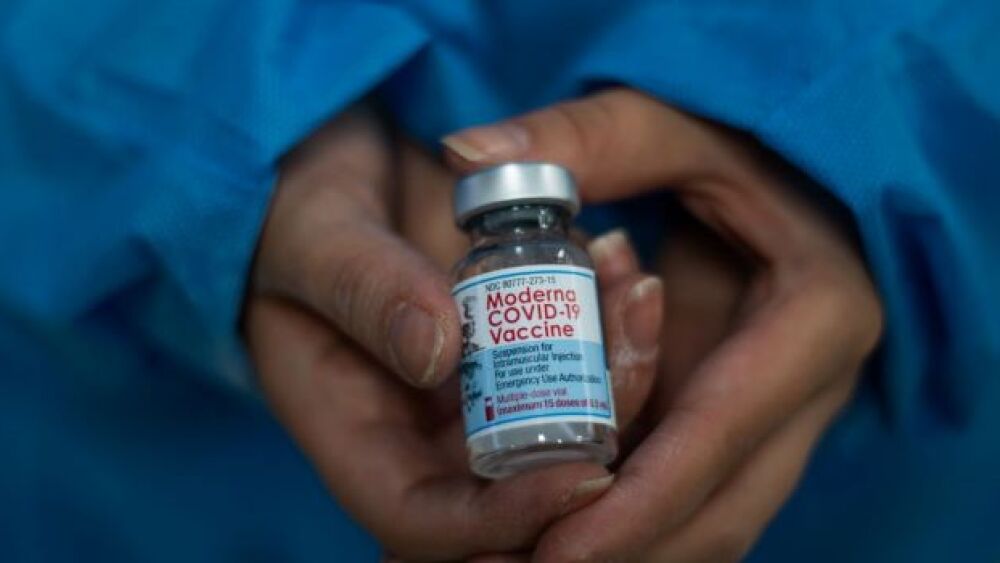Moderna’s study, dubbed BabyCove, is expected to begin recruiting in September and will include up to 700 babies three to six months of age.
Only a day after the U.S. Food and Drug Administration’s Vaccines and Related Biological Products Advisory Committee voted unanimously to recommend emergency use authorization (EUA) for Moderna’s COVID-19 vaccine for children ages six to 17 and kids six months through five years, the company is planning to test the vaccine in babies three to six months of age. Company stock popped $5.7% to $128.53 at the news.
According to The Wall Street Journal, the study is dubbed BabyCove and is expected to begin recruiting in September and will include up to 700 babies.
Moderna’s vaccine is authorized for adults 18 years and older. Its EUA is likely to be amended to include children six months to 17 years by next week once the FDA decides and passes it on to the Center for Disease Control and Prevention (CDC)’s advisory panel.
During the FDA advisory meeting to discuss the Moderna and Pfizer-BioNTech vaccines for kids, Dr. Jacqueline Miller, M.D., Moderna’s senior vice president and head of infectious disease research, indicated the study will represent the youngest age group yet and would be designed to evaluate an appropriate dose level. A company spokesperson also said it would study the most updated version of the vaccine. It’s unclear if they mean the bivalent vaccine that includes the original Spikevax vaccine and a vaccine targeting Omicron, although it suggests it does.
Late last week, Moderna announced results from its Omicron-containing COVID-19 booster candidate, mRNA-1273.214. Containing Spikevax and an Omicron-targeted vaccine, the Phase II/III trial demonstrated superior antibody response against Omicron. This was in adults and utilized a 50-microgram booster dose. It met all pre-specified endpoints, including superior neutralizing antibody response against Omicron one month after dosing compared to the original Spikevax vaccine. The company expects to submit the data to regulators soon with expectations that it will be authorized and available to the public by late summer.
The adult dosage of the COVID-19 Spikevax vaccine is 100 micrograms per dose. Teens ages 12 to 17 also receive 100 micrograms per dose. For children ages six to 11, it’s half that, 50 micrograms per dose. Although the company hasn’t made an announcement on dosing for BabyCove, the dosage is likely to be even smaller.
During yesterday’s advisory committee hearing, Dr. Paul Offit, M.D., a committee member and pediatrician and infectious disease expert at Children’s Hospital of Philadelphia, said two lower doses weren’t likely to offer protection against mild illness from the Omicron subvariants but would likely protect against severe disease with a third dose.
“I think the benefits clearly outweigh the risks, but I say that with the comfort being provided that there will be a third dose. If that was not true, I wouldn’t feel the same way,” Offit said. “We’re not in the same part of this pandemic anymore. It’s a different time.”
Currently, children ages five and older are eligible for the Pfizer-BioNTech vaccine, although uptake for that age group has been lower than expected. As of early June, approximately 30% of children ages five to 11 and 60% of kids 12 to 17 are fully vaccinated.
Moderna initially requested the FDA authorize its vaccine for kids 12 to 17 in June 2021. But the FDA delayed the decision after international data suggested the Moderna vaccine had a higher risk of myocarditis or heart inflammation than the Pfizer-BioNTech shot. Moderna then requested authorization for kids six to 11 in March of this year.
U.S. data through May didn’t find a significantly higher risk of myocarditis with Moderna’s shots compared to the Pfizer-BioNTech jabs in men ages 18 to 25. The CDC also found that the risk of myocarditis was higher from COVID-19 infection than from vaccination. Myocarditis is often caused by viral infections.
For example, out of the 54 million Pfizer-BioNTech shots given, there were only 635 cases of myocarditis in kids ages five through 17, with the risk being the highest for boys 12 to 17 after the second dose. The risk for kids five to 11 does not appear to be increased.
Kids are less likely to become infected and have severe diseases from COVID-19 than adults, particularly older adults. However, the Omicron variant and its subvariants increase the risk. There have been 442 deaths in children under the age of five from COVID-19 in the U.S. Featured Jobs on BioSpace





